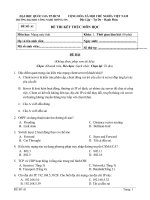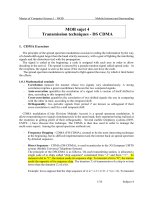Đề thi MOB MOB
Bạn đang xem bản rút gọn của tài liệu. Xem và tải ngay bản đầy đủ của tài liệu tại đây (148.3 KB, 4 trang )
UNIVERSITÉ NATIONALE DE HO CHI MINH VILLE
PÔLE UNIVERSITAIRE FRANÇAIS HO CHI MINH VILLE
TEST
Subject: MOB (TD)
Duration: 90 minutes;
Note: Remember to mark your answers on the answer sheet and NOT on the test booklet. Exam code
132
Name:..........................................................................
Student’s code:...............................................................................
Question 1: How many frequencies does a full-duplex QAM-64 modem use?
A. 1 B. 12 C. 6 D. 2
Question 2: An analog cellular system has 20 MHz of band-width and uses two channels simplex of
25 kHz to provide a transfer service of full-duplex. What is the number of full-duplex channels
available by cell for a reuse factor K = 4?
A. 400 B. 200
C. 100 D. A, B and C are wrong
Question 3: A modem constellation diagram similar to figure. How
many bps can a modem with these parameters achieve at 1200
baud?
A. 4800bps B. 2400bps
C. 1200bps D. A, B and C are wrong
Question 4: Ten signals, each requiring 4000Hz, are multiplexed on to a single channel using FDM.
How much minimum bandwidth is required for the multiplexed channel? Assume that the guard
bands are 400Hz wide.
A. 40800Hz B. 40400Hz
C. 44000Hz D. A, B and C are wrong
Question 5: The spectrum of a channel is between 2.4 GHz and 2.401 GHz and SNR
dB
= 4 dB. For
this channel the bit rate is?
A. ≈ 485427bps B. ≈ 2321928bps
C. ≈ 1812246bps D. A, B and C are wrong
Question 6: Suppose a transmitter produces 50W of power. The transmitter’s power is applied to a
unity gain antenna with a 900MHz carrier frequency. The close-in distance is d
0
= 100m. The value
P
r
(d
0
) may be predicted from equation
Ld
GGP
P
rtt
r
22
2
)4(
π
λ
=
, where G
t
, G
r
are antenna gain at transmitter,
receiver, and L ≥ 1 is the system loss factor. If P
r
is in unit of dBm, the received power is given by
P
r
(d) = 10log
10
[P
r
(d
0
)/0.001] + 20log
10
(d
0
/d), where d≥d
0
. What is the received power at a free space
distance of 10km?
A. ≈ −24.5dBm B. ≈ −64.5dBm
C. ≈ +64.5dBm D. A, B and C are wrong
Question 7: A channel has a bit rate of 5 kbps and a propagation delay of 20 msec. For what range of
frame sizes does stop-and-wait give an efficiency of at least 50%?
A. frame size < 100 bits B. 100 bits < frame size < 200 bits
C. frame size > 200 bits D. frame size < 200 bits
Question 8: Need to share with each subnet have 510 hosts maximum in a class B address, should
use the Subnet Mask?
A. 255. 255. 255.0 B. 255. 255. 255.192 C. 255. 255.252.0 D. 255.255.254.0
Page 1/4 - Exam code 132
π/43π/4
5π/4
7π/4
A
1101
00
10
Question 9: Suppose that 1 MHz is dedicated to the control channels and that only a control channel
is necessary by cluster; determine a reasonable distribution of the voice traffic channels for each cell,
for the 9 reuse factors given previously.
A. 8 cells with 53 voice channels and 4 cells with 54 voice channels
B. 8 cells with 71 voice channels and 1 cell with 72 voice channels
C. 4 cells with 91 voice channels and 3 cells with 92 voice channels
D. A, B and C are wrong
Question 10: The signal can be written
−
−
+
+
=
10)4/2cos(
00)4/32cos(
01)4/32cos(
11)4/2cos(
)(
fortfA
fortfA
fortfA
fortfA
ts
c
c
c
c
ππ
ππ
ππ
ππ
.
What is the modulation type?
A. QAM-4 B. PSK-4 C. PSK-2 D. QAM-2
Question 11: A typical
Bluetooth data frame
describe in figure.
Which field determines
the active devices?
A. Header B. Access code C. Address D. Checksum
Question 12: If the diameter of receiving antennas parabolas is 30 cm, what is the frequency
concerned?
A. 1GHz B. 1MHz
C. 1kHz D. A, B and C are wrong
Question 13: The signal can be written
=
00
1)2cos(
)(
binaryfor
binaryfortfA
ts
c
π
.
What is the modulation type?
A. ASK-2 B. ASK-4 C. PSK-2 D. QAM-2
Question 14: The output power at transmitter is 1W, power received is 100mW. The gain is?
A. −10 dB B. 100 C. 10 dB D. 1
Question 15: A telephone line has a bandwidth of 4kHz. The signal-to-noise ratio is 3162. For this
channel the capacity is?
A. ≈ 46480 bps B. ≈ 40000 bps
C. ≈ 37944 bps D. A, B and C are wrong
Question 16: Suppose a frequency reuse pattern similar to figure.
The radius of a cell is 800m. What is the minimum distance
between centers of cells that use the same band of frequencies?
A. ≈ 3666m B. ≈ 4850m
C. ≈ 9699m D. A, B and C are wrong
Question 17: What is the baud rate of the standard 10-Mbps Ethernet?
A. 10 Mega baud B. 20 Mega baud C. 30 Mega baud D. 5 Mega baud
Question 18: The power of a signal is 100 mW and the power of the noise is 1W; what are the values
of SNR
dB
?
Page 2/4 - Exam code 132
A. +100 dB B. +10 dB C. 0.1 D. −10 dB
Question 19: Assume that the TV picture is to be transmitted over a channel with 4.5MHz bandwidth
and a 35dB signal-to-noise ratio. Find the capacity of the channel?
A. ≈ 46.6Mb/s B. ≈ 23.3Mb/s
C. ≈ 52.3Mb/s D. A, B and C are wrong
Question 20: The output power of the transmitter is 100 mW and its antenna gain is 2 dBi,
performing in the 2.4 GHz. The card sensitivity is -85 dBm for 11 Mbit/s. If you suppose both
antennas are in direct line of sight and if you don’t consider additional losses. What will be the
maximum propagation range?
A. ≈ 14km B. ≈ 70km
C. ≈ 29km D. A, B and C are wrong
Question 21: Four transmitter having key A: (−1 −1 −1 +1 +1 −1 +1 +1), B: (−1 −1 +1 −1 +1 +1 +1
−1), C: (−1 +1 −1 +1 +1 −1 −1 −1) and D: (−1 +1 −1 −1 −1 −1 +1 −1). The received chip sequence is
(−2 −2 0 −2 0 −2 +4 0). What happened?
A. A, B send bit 1 and C, D send bit 0 B. A, B, C and D send bit 1
C. A, B, C and D send bit 0 D. A, B and D send bit 1, C send bit 0
Question 22: The transmitter is performing in the 2.4 GHz. What the height shall you place the
antennas above the ground?
A. ≈ 1m B. ≈ 20m
C. ≈ 0.66m D. A, B and C are wrong
Question 23: What is the minimum E
b
/N
0
required to achieve a channel of low-pass type has a band-
width of 1 MHz and a SNR = 3162?
A. ≈ 11 B. ≈ 272
C. ≈ 10.65 dB D. A, B and C are wrong
Question 24: The channel of low-pass type has a band-width of 4.5 MHz and a SNR = 3162. What is
the maximum spectral efficacy that one can theoretically reach on such a channel?
A. ≈ 38.4Baud/s B. ≈ 862bit/s/Hz C. ≈ 52321850bit/s D. ≈ 11.63bit/s/Hz
Question 25: The digital video having the following characteristics: matrix of 480×640 pixels where
each pixel corresponds to an intensity which can take 32 different values. The required speed is of 25
images per second. What is the modulation rate of the video source?
A. ≈ 7680000b/s B. ≈ 38.4Mb/s C. ≈ 7680000Baud/s D. ≈ 38.4Baud/s
Question 26: The relationship between bit rate and modulation rate?
A. R ≤ 2B B. C = B log
2
(1 +
N
S
) C. R =
T
S
1
D. D = R × n
Question 27: In the cellular network, Q = D/R called co-channel reuse ratio. Suppose i = 3 and j = 1.
What is the Q?
A. ≈ 6 B. ≈ 6.24
C. ≈ 4.58 D. A, B and C are wrong
Question 28: For the network address 172.16.0.0/16. How many subnets this network can be split
up?
A. 16 B. 2
14
C. 2
16
D. A, B and C are wrong
Question 29: The telephone line is now to have a loss of 20dB. The input signal power is measured
as 0.5W, and the output noise level is measured as 4.5µW. Calculate the output SNR in dB?
A. ≈ −30.5dB B. ≈ +30.5dB
C. ≈ −89dB D. A, B and C are wrong
Question 30: Suppose a transmitter produces 50W of power. If the transmitter’s power is applied to a
unity gain antenna with a 900MHz carrier frequency, what is the received power in dBm at a free
Page 3/4 - Exam code 132
space distance of 100m? The value P
r
(d
0
) may be predicted from equation
Ld
GGP
P
rtt
r
22
2
)4(
π
λ
=
, where G
t
,
G
r
are antenna gain at transmitter, receiver, and L ≥ 1 is the system loss factor.
A. ≈ +47dBm B. ≈ −24.5dBm
C. ≈ +24.5dBm D. A, B and C are wrong
Question 31: One class A address borrowed 21 bits to divide subnet, the Subnet Mask is?
A. 255.255.255.248 B. 255.255.224.0 C. 255.255.192.0 D. 255.255.248.0
Question 32: The radius of a cell in cellular network is 1600m. What is the distance between centers
of adjacent cells?
A. ≈ 2770m B. ≈ 1600m
C. ≈ 3200m D. A, B and C are wrong
Question 33: Consider a noiseless channel with a bandwidth of 3000 Hz transmitting a signal with 16
signal levels. The maximum bit rate can be?
A. 48000 bps B. 3000 bps C. 12000 bps D. 6000 bps
Question 34: A group of N stations share a Slotted ALOHA channel of 1 Mb/s. Each station emits in
average a frame of 12000 bits/second. By taking again the results obtained for S
max
(maximum
efficiency) determine the maximum value of N that one can have?
A. ≈ 300 B. ≈ 700
C. ≈ 600 D. A, B and C are wrong
Question 35: One takes the antenna gains into account; microwaves transmitter has an output power
of 0.1W at 2 GHz. The EIRP of the transmitted signal is 10W. What is the wavelength of receiving
antennas parabolas?
A. ≈ 1.2m B. ≈ 0.64m
C. ≈ 0.32m D. A, B and C are wrong
Question 36: The network’s Subnet Mask is 255.255.255.224, determine its broadcast address if that
a computer which has the address 192.168.1.1?
A. 192.168.1.255 B. 192.168.1.15 C. 192.168.1.31 D. 192.168.1.96
Question 37: Consider building a CSMA/CD network running at 1 Gbps over a 1–km cable with no
repeaters. The signal speed in the cable is 200000 km/sec. What is the minimum frame size?
A. 500 bits B. 5000 bits C. 1000 bits D. 10000 bits
Question 38: What is EIRP of a dipole antenna fed with a power of 100 mW?
A. ≈ 100mW B. ≈ 0.1W
C. ≈ 0.16W D. A, B and C are wrong
Question 39: We need to send 56 kbps over a noiseless channel with a bandwidth of 4 kHz. How
many signal levels do we need?
A. 1 B. 64 C. 2 D. 128
Question 40: Which modulation does a constellation diagram
correspond to?
A. QAM-4 B. PSK-4 C. PSK-2 D. QAM-2
-----------------------------------------------
----------- The end ----------
Page 4/4 - Exam code 132
π/43π/4
5π/4
7π/4
A
1101
00
10









